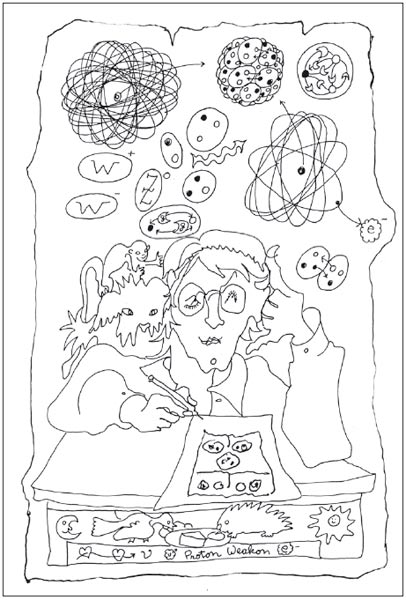
Image credit: Jutta Waloschek.
Do you remember? If you are old enough you certainly will. I refer to the sixth decade of last century, when the research centres CERN and DESY were created. About that time I tried to explain to my sister Jutta (an artist who always considered logarithms as some species of worms) our understanding of the structure of matter. I started with the usual story about all visible matter being made of molecules which in turn are composed of atoms. And all atoms are made of very small particles called protons, neutrons and electrons. I even tried to explain some details on nuclear, electromagnetic and gravitational forces; three basic particles and three forces, an elegant and simple scheme. I left out solar energy and radioactivity.
But Jutta was not happy. In the early 1950s she came with us to the Andes mountains to expose nuclear emulsions in which we searched for cosmic mesons and hyperons. Jutta was also an attentive observer during the many evenings that I spent with Gianni Puppi in the ancient building of the Physics Institute of Bologna, scanning bubble-chamber pictures provided from the US by Jack Steinberger. We were looking for so called Λ and θ particles, trying to learn about their spin and some difficult-to-understand parity violation. So Jutta knew that there were many more particles and effects in existence, which I could not explain to her.
And, at a certain point, we particle physicists did not like the situation either. Our initial excitement with the discovery of exotic particles did not last long. We were not pleased with the several hundred particles and excited states (most of them unstable) that had been found but which did not fit into our traditional scheme of the structure of stable matter. There was no good reason for them to exist. It seemed at a certain moment quite useless to continue adding more and more particles to this “particle zoo” as it was condescendingly called. We were just making a kind of “particle spectroscopy” with no visible goal in mind.
In addition, at that time we had already been forced to abandon our beloved organization in small university groups, each one proud of their individual discoveries. Now, it was often the case that several of these groups had to join forces to reach significant results. One extreme example was a collaboration of about a hundred physicists on a single project to expose an enormous emulsion stack in the higher atmosphere and subsequently to undertake its inspection. Results were published with more than a hundred authors on a single paper, a kind of horror vision for individualists. It was the beginning of the international globalization of research, initiated (as are so many other issues) by particle physicists.
But none of this helped us understand the particle zoo. There was general agreement that new ways should be found, perhaps by the systematic study of reactions at higher energies. It was in this period that the European research centre CERN was created in 1954. Other local accelerator projects were started in a number of countries too, some of which were designed as a complement to the planned proton accelerator at CERN. A group of German physicists were dreaming about an electron machine, and this led to the foundation of DESY in Hamburg exactly 50 years ago.
However, life for electron-accelerator enthusiasts was not easy. While most particle physicists agreed about building proton machines, several did not accept the idea of working with electrons. I remember serious claims that everything related to electrons and electric charges could be accurately calculated within the framework of quantum electrodynamics. Consequently nothing new could be learnt from experimenting with electrons. Fortunately this was wrong!
The results of the following 50 years of global research are well known. Single papers are now often signed by more than a thousand authors and our understanding of the inner structure of matter has improved by a factor of thousand. The existence of most of the particles of our zoo can be understood and their inner structure has been explained (including our protons and neutrons). Quarks and leptons as basic particles and several fundamental forces with their exchange quanta form an elegant scheme called the “Standard Model of particle physics”. There are still some problems to solve, but I did try again to explain the basics to my sister Jutta. She illustrated her feelings after our last discussion.







